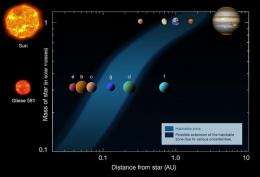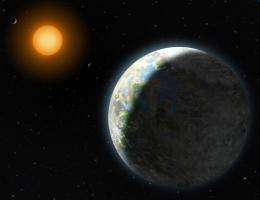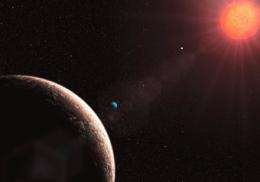Astronomers are re-thinking the requirements that need to be met for an exoplanet to be considered 'habitable.' A new simulation of the Gliese 581 system is helping astrobiologists refine their search for Earth-like worlds in the Universe. Gleise 581 recently made news because a planet could be orbiting within the system's habitable zone.
The Gliese 581 system has been making headlines recently for the most newly announced planet that may lie in the habitable zone. Hopes were somewhat dashed when we were reminded that the certainty level of its discovery was only 3 sigma (95%, whereas most astronomical discoveries are at or above the 99% confidence level before major announcements), but the Gliese 581 system may yet have more surprises.
The potential habitable zone of the Gliese 581 system as compared to our own solar system. Credit: Universe Today
When the second planet, Gliese 581d, was first discovered, it was placed outside of the expected habitable zone. But in 2009, reanalysis of the data refined the orbital parameters and moved the planet in, just to the edge of the habitable zone. Several authors have suggested that, with sufficient greenhouse gases, this may push Gliese 581d into the habitable zone.
A new paper to be published in an upcoming issue of Astronomy & Astrophysics simulates a wide range of conditions to explore just what characteristics would be required.
The team, led by Robin Wordsworth at the University of Paris, varied properties of the planet including surface gravity, albedo, and the composition of potential atmospheres. Additionally, the simulations were also run for a planet in a similar orbit around the sun (Gliese 581 is an M dwarf) to understand how the different distribution of energy could effect the atmosphere.
Artist impression of Gliese 581 g, which is thought to have three times the mass of Earth. Credit: Lynette Cook
The team discovered that, for atmospheres comprised primarily of CO2, the redder stars would warm the planet more than a solar type star due to the CO2 not being able to scatter the redder light as well, thus allowing more to reach the ground.
One of the potential roadblocks to warming the team considered was the formation of clouds. The team first considered CO2 clouds which would be likely towards the outer edges of the habitable zone and form on Mars. Since clouds tend to be reflective, they would counteract warming effects from incoming starlight and cool the planet. Again, due to the nature of the star, the redder light would mitigate this somewhat allowing more to penetrate a potential cloud deck.
Should some H2O be present its effects are mixed. While clouds and ice are both very reflective, which would decrease the amount of energy captured by a planet, water also absorbs well in the infrared region. As such, clouds of water vapor can trap heat radiating from the surface back into space, trapping it and resulting in an overall increase. The problem is getting clouds to form in the first place.
The inclusion of nitrogen gas (common in the atmospheres of planets in the solar system) had little effect on the simulations. The primary reason was the lack of absorption of redder light. In general, the inclusion only slightly changed the specific heat of the atmosphere and a broadening of the absorption lines of other gasses, allowing for a very minor ability to trap more heat. Given the team was looking for conservative estimates, they ultimately discounted nitrogen from their final considerations.
Astronomers have discovered many planets orbiting the star Gliese 581. This artist’s representation shows Gliese 581 e (foreground), which is only about twice the mass of our Earth. Other confirmed planets in the system are 16 (planet b, nearest to the star), 5 (planet c, center), and 7 Earth-masses (planet d, with the bluish color). Credit: ESO
With the combination of all these considerations, the team found that even given the most unfavorable conditions of most variables, should the atmospheric pressure be sufficiently high, this would allow for the presence of liquid water on the surface of the planet, a key requirement for what scientists maintain is critical for abiogenesis. The favorable merging of characteristics other than pressure were also able to produce liquid water with pressures as low as 5 bars. The team also notes that other greenhouse gasses, such as methane, were excluded due to their rarity, but should the exist, the ability for liquid water would be improved further.
Ultimately, the simulation was only done as a one dimensional model which essentially considered a thin column of the atmosphere on the day side of the planet. The team suggests that, for a better understanding, three dimensional models would need to be created.
In the future, they plan to use just such modeling which would allow for a better understanding of what was happening elsewhere on the planet. For example, should temperatures fall too quickly on the night side, this could lead to the condensation of the gasses necessary and put the atmosphere in an unstable state.
Additionally, as we discover more transiting exoplanets and determine their atmospheric properties from transmission spectra, astronomers will better be able to constrain what typical atmospheres really look like.
Source: Astrobio.net, via Universe Today (universetoday.com)


























